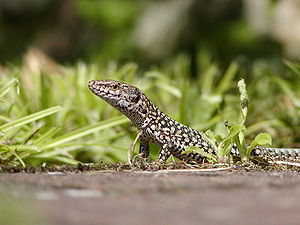Cycladic wall lizard
| Cycladic wall lizard | ||||||||||||
|---|---|---|---|---|---|---|---|---|---|---|---|---|

Cycladic wall lizard ( Podarcis erhardii ) |
||||||||||||
| Systematics | ||||||||||||
|
||||||||||||
| Scientific name | ||||||||||||
| Podarcis erhardii | ||||||||||||
| ( Bedriaga , 1882) |
The Cycladic wall lizard ( Podarcis erhardii ), also known as the Aegean wall lizard , belongs to the genus of the wall lizards ( Podarcis ) within the family of real lizards (Lacertidae ). The species was scientifically described in 1882 by the Russian herpetologist Jacques von Bedriaga .
features
The Cycladic wall lizard reaches a body length of up to 21 centimeters. The body is built very slim and the flat head is only slightly separated from the neck. The scales are smooth. Some island populations are growing larger than mainland populations. The basic color of the lizard is between gray and brown. Her legs are lightly spotted and a dark net markings can be seen on her back from the neck to the base of the tail. The lower flanks often have a row of bluish spots. In addition, the (usually white) belly is sometimes orange-red. The species usually shows a clear sexual dimorphism . Often the back of the male is greenish and the female draws two light vertical stripes.
Way of life
The Cycladic wall lizard is a nimble diurnal lizard that hides in cracks in walls, leaves or vegetation in a flash when threatened. The species bathes extensively in the sun, climbs well, and eats all sorts of small insects and spiders . The males form territories and fight fierce battles with one another during the mating season. Podarcis erhardii reproduces through oviparity (laying eggs). After mating, the female creates a clutch of two to four eggs.
Subspecies
The Reptile Database currently lists 21 subspecies of the Cycladic wall lizard:
- Podarcis erhardii amorgensis ( Werner , 1933)
- Podarcis erhardii biinsulicola ( Wettstein , 1937)
- Podarcis erhardii buchholzi ( Wettstein , 1956)
- Podarcis erhardii erhardii ( Bedriaga , 1876)
- Podarcis erhardii kinarensis ( Wettstein , 1937)
- Podarcis erhardii levithensis ( Wettstein , 1937)
- Podarcis erhardii livadiaca ( Werner , 1902)
- Podarcis erhardii makariaisi ( Wettstein , 1956)
- Podarcis erhardii megalophthenae ( Wettstein , 1937)
- Podarcis erhardii mykonensis ( Werner , 1933)
- Podarcis erhardii naxensis ( Werner , 1899)
- Podarcis erhardii ophidusae ( Wettstein , 1937)
- Podarcis erhardii pachiae ( Wettstein , 1937)
- Podarcis erhardii phytiusae ( Wettstein , 1937)
- Podarcis erhardii riveti ( Chabanaud , 1919)
- Podarcis erhardii ruthveni ( Werner , 1930)
- Podarcis erhardii subobscura ( Wettstein , 1937)
- Podarcis erhardii syrinae ( Wettstein , 1937)
- Podarcis erhardii thermiensis ( Werner , 1935)
- Podarcis erhardii thessalica ( Cyrén , 1938)
- Podarcis erhardii zafranae ( Wettstein , 1937)
distribution
The distribution area of the Cycladic wall lizard is in the coastal countries of the eastern Mediterranean and on several Aegean islands . It occurs in Greece , Albania , Bulgaria and Serbia up to 2000 meters above sea level. Their habitat are rocky dry areas with pronounced bush vegetation, but also overgrown gardens with dry stone walls.
Hazard and protection
The International Union for Conservation of Nature IUCN classifies the Cycladic Wall Lizard as not endangered and the population as stable. However, some populations are declining regionally, which is related to the destruction of the natural habitat as a result of tourism.
swell
literature
- Ulrich Gruber: Amphibians and Reptiles. 2nd Edition. Kosmos, Stuttgart 2002, ISBN 3-440-09212-7 .
Individual evidence
- ↑ Podarcis erhardii in The Reptile Database ; Retrieved November 27, 2014.
- ↑ a b IUCN Red List: Podarcis erhardii